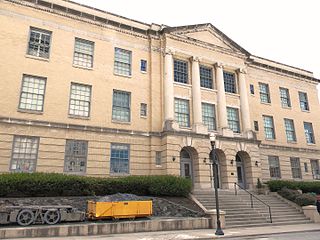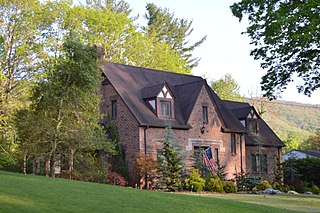
Bluefield is a town in Tazewell County, Virginia, United States, located along the Bluestone River. The population was 5,096 at the 2020 census. It is part of the Bluefield WV-VA micropolitan area which has a population of 106,363 in 2020.

Downtown Martinsburg Historic District is a national historic district located at Martinsburg, Berkeley County, West Virginia. It encompasses 281 contributing buildings. It includes government and industrial buildings, several schools, firehouses, and churches, the two main commercial and professional areas along Queen and King Streets, a major hospital, and surrounding residential areas. The buildings reflect a number of popular 19th-century architectural styles including Gothic Revival, Italianate, and Queen Anne.

Sutton Downtown Historic District is a national historic district located at Sutton, Braxton County, West Virginia. It encompasses 85 contributing buildings and two contributing structures covering eleven square blocks. The district includes the commercial, ecclesiastical, and civic core of the town and surrounding residential area. The district includes a number of buildings representative of popular architectural styles from the late-19th century and early-20th century including Romanesque Revival, Colonial Revival, Gothic Revival, and Greek Revival. Notable buildings include the Braxton County Courthouse (1881-1882) and Jail (1905), Sutton Bank Building (1891), Farmers Bank and Trust (1909), Bank of Sutton, Methodist Episcopal Church, South (1896), Kelly / Fisher House. Elk / Midway Hotel (1894), and Katie B. Frame Residence. The two structures are the Bridge over Old Woman Run (1892) and Bridge over Elk (1930).

West Union Downtown Historic District is a national historic district located at West Union, Doddridge County, West Virginia. It encompasses 27 contributing buildings that include the commercial and civic core of the town, and surrounding residential buildings. The district includes a number of buildings representative of popular architectural styles from the late-19th century and early-20th century including Romanesque Revival, Neoclassical, and Queen Anne. Notable buildings include the Doddridge County Courthouse (1903) and Jail, Scott W. Stuart House, Silas P. Smith House, Town Hall (1893), Droppleman Residence, Michel's Pharmacy (1925). Empire Oil Building, and Myles Manufacturing Co., Inc.. Also located in the district is the separately listed Silas P. Smith Opera House.

Grafton Downtown Commercial Historic District is a national historic district located at Grafton, Taylor County, West Virginia. It encompasses 72 contributing buildings and two contributing structures. They include the business and commercial core of Grafton. Most of the buildings in the district date from 1890–1920 and are generally of brick or frame construction. Notable buildings include the Grafton Hotel and the B & O station, both built in 1911 and the Post Office built in 1913. Located in the district and separately listed is the Andrews Methodist Church.

Downtown Buckhannon Historic District is a national historic district located at Buckhannon, Upshur County, West Virginia. It encompasses 57 contributing buildings and one contributing structure that include the civic and commercial core of Buckhannon. Most of the buildings in the district date from the late-19th and early-20th century in popular architectural styles, such as Italianate, Queen Anne, Colonial Revival, and Classical Revival. Notable buildings include the Presbyterian Church on Locust Street (1879), T. L. Stockert Building (1908), Peoples Bank Building (1910), Upshur County Court House, and U.S. Post Office (1916).

Downtown Huntington Historic District is a national historic district located at Huntington, Cabell County, West Virginia. The original district encompassed 59 contributing buildings; the boundary increase added 53 more contributing buildings. It includes the central business district of Huntington and includes several of its municipal and governmental buildings. It contains the majority of the historic concentration of downtown commercial buildings. Located in the district are the separately listed Carnegie Public Library, Cabell County Courthouse, U.S. Post Office and Court House, and Campbell-Hicks House.

Alexander Blount Mahood was a Bluefield, West Virginia-based architect.

Municipal Building, also known as Old Bluefield Municipal Building, is a historic municipal building located at Bluefield, Mercer County, West Virginia. It was built in 1924, and is a two- to three-story, steel and reinforced concrete Classical Revival-style building. It features a three-story high pedimented central pavilion with four engaged Ionic order columns. In 1977, the city government of Bluefield moved to its new building.

Jefferson Street Historic District is a national historic district located at Bluefield, Mercer County, West Virginia. The district includes 63 contributing buildings in a residential area of Bluefield known as Oakland Addition, originally platted in 1910. The buildings are primarily single-family residences with a few multiple family dwellings, and one church, the College Avenue Baptist Church. Houses are representative of popular architectural styles from the turn of the 20th century, including American Four Square, Bungalow, Colonial Revival, and Classical Revival. A number of the homes were designed by architect Alex B. Mahood.

South Bluefield Historic District is a national historic district located at Bluefield, Mercer County, West Virginia. The district includes 84 contributing buildings in a residential area of Bluefield known as South Bluefield. The buildings are primarily large single family residences with broad lawns, landscaped entrances and yards. The properties were mostly developed between 1930 and 1940, and are representative of popular architectural styles including Colonial Revival and Classical Revival. A number of the homes were designed by architect Alex B. Mahood.

Upper Oakhurst Historic District is a national historic district located at Bluefield, Mercer County, West Virginia. The district includes 37 contributing buildings in a residential area adjacent to South Bluefield. The buildings are primarily large single-family residences on large lots. The properties were mostly developed during the 1920s, and are representative of popular architectural styles, including Colonial Revival and Classical Revival. A number of the homes were designed by architect Alex B. Mahood.
Country Club Hill Historic District is a national historic district located at Bluefield, Mercer County, West Virginia. The district includes 51 contributing buildings in a residential area of South Bluefield. The buildings are primarily large single family residences with generous front and rear yards. The properties were mostly developed prior to 1940, and are representative of popular architectural styles including Colonial Revival, Classical Revival, and Bungalow styles. The Bluefield Country Club (1920) and some of the houses were designed by architect Alex B. Mahood.

The Downtown Morgantown Historic District is a federally designated historic district in Morgantown, Monongalia County, West Virginia. The district, encompassing approximately 75 acres, has 122 contributing buildings and 2 contributing sites including commercial and public buildings, residences, and churches. The district has been listed on the National Register of Historic Places since May 2, 1996. Ten of the contributing buildings are listed separately on the National Register of Historic Places. Significant structures located within the historic district are the Monongalia County Courthouse, the Metropolitan Theater, and the Old Morgantown Post Office.

Downtown Richwood Historic District is a national historic district located at Richwood, Nicholas County, West Virginia. The district includes 51 contributing buildings in the central business district of Richwood. They consist of mostly two and three-story masonry commercial buildings from the late 19th and early 20th century. They have storefronts on the first floor and house on the upper floors. Notable buildings include the U.S. Post Office (1936), First Methodist Church (1922) designed by Levi J. Dean, Richwood Banking and Trust Building (1902), and New Star Theatre, also by Levi J. Dean.

Downtown Rowlesburg Historic District is a national historic district located at Rowlesburg, Preston County, West Virginia. The district encompasses 51 contributing buildings and 1 contributing site in the central business district and surrounding residential areas of Rowlesburg. Most of the commercial buildings are two story, frame and masonry buildings, dating from about 1900 to 1950. Notable buildings include the St. Paul's Methodist Protestant Church (1923), St. Philomena's Roman Catholic Church, Trinity Methodist Episcopal Church (1915), Rowlesburg School, Waybright House, Weaver House, Nassif Home and Store building, Rowlesburg Area Historical Society/IOOF building (1875), and Adams and Moore Store building (1907).

Downtown Elkins Historic District is a national historic district located at Elkins, Randolph County, West Virginia. It encompasses 65 contributing buildings in the central business district of Elkins. It includes mostly commercial buildings constructed in the late-19th and early-20th century. Notable buildings include the Dann Building (1897), Randolph Company (1896), Randolph Hotel (1893), Wallace Bakery (1895), railroad depot (1908), Ward Building (1908), First United Methodist Church (1904), Hotel Delmonte (1899), Darden Block (1906), Brown Building (1906), Stalnaker Block (1900), and Post Office and Federal Building.

Harrisonburg Downtown Historic District is a national historic district located at Harrisonburg, Virginia. The district encompasses 161 contributing buildings, 1 contributing structure, and 2 contributing objects in the central business district of Harrisonburg. The district includes a variety of commercial, residential, institutional, and governmental buildings dating from the late-18th to mid-20th century. There are notable examples of the Queen Anne and Greek Revival styles.

The Main Street Banking Historic District is a national historic district located in downtown Richmond, Virginia. The district encompasses 19 contributing buildings located south of the Virginia State Capitol and west of the Shockoe Slip Historic District. It is the location of a number of buildings built for or occupied by banking institutions. The district includes representative examples of the Late Victorian and International Style architecture built between about 1865 and 1965. Notable buildings include the Virginia Employment Commission Building (1960), the 700 Building (1964), the Ross Building (1964), the Fidelity Building (1965). Located in the district is the separately listed First National Bank Building.
The Bluefield Green Book Historic District comprises two buildings in Bluefield, West Virginia, that were used as hotels and apartments catering to African-American travelers during the segregation era of the mid-20th century. The Traveler's Inn Hotel was built in 1920, and the Hotel Thelma was built in 1948-49 on an adjoining lot on Wayne Street. Both were listed in the Negro Motorist Green Book. The Hotel Thelma was listed from 1950 to 1961, and the Traveler's Inn Hotel was listed from 1959 to 1966.





















